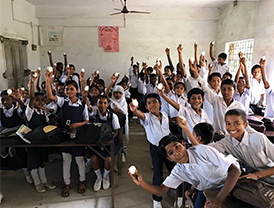Using ND Filters
I am novice in photography. While practicing with ND8 filter in broad daylight, I notice that my pictures came out dark. Please help me to use ND filter properly. Is it necessary to meter the scene before attaching the filter?
Rajesh Mondal, via email
The purpose of using an ND (Neutral Density) filter is to reduce the amount of light entering the lens, with the aim to prolong the exposure. As an example, you may want to photograph flowing water. By using the appropriate strength ND filter (camera on a tripod), you can use slower shutter speed, which in turn would give an impression of flowing water.
Unfortunately, you have not included a picture that can let me ascertain the problem. I suspect that you metered the scene in Manual Exposure mode, placed the 3-stop (ND8) filter but did not reduce the shutter speed by 3 stops. If you were in Aperture Priority mode for example, the camera would have automatically compensated for the filter and provided you with a correct exposure.
You meter the scene (in Aperture Priority mode) without the ND filter in place and take a shot. Now study the image. If the water does not appear ‘flowing’, it means that your shutter speed is too fast (for the used aperture). Now place the ND filter and shoot again. Check the result. If you want the water to appear even more silky smooth, use a ND filter of greater strength. You may have to do some trial and error to find the correct strength of the ND filter to use for a particular effect.

 Fashion Photography Related
Fashion Photography Related
I am a amateur photographer and I want to be a fashion photographer.
1) What are the basic kit requirements for a fashion photographer?
2) I also want to know about filters, flash, lights and bag to purchase for a camera.
My budget can be in medium range for all, individually.
Shreya Phadke, via email
1) By saying “basic kit” did you mean only the camera/lens part of it or did you mean ‘all that is required to start with fashion photography’? The answer would depend on whom you ask.
a) A full-frame D-SLR with around a 24-120mm lens / an APS-C sensor model with around a 16-80mm lens.
b) Two or three studio lights with white umbrellas / soft boxes.
c) A roll of white paper for a backdrop (by careful use of the lighting, the backdrop can be made to look gray or almost black).
d) A support system for holding the backdrop.
e) A flash meter (you could of course get closer to a good exposure by trial and error – by checking the image on the camera LCD).
f) Miscellaneous items like ‘cutters’ (to prevent stray light hitting areas where you don’t want the light to hit); ‘snoot’ (to direct the light to a narrower area; light stands; reflectors; props for the model.
Besides the above, one should have a reasonably sound knowledge of using the camera, lighting, posing the model, etc.
2) Your query needs to be specific.
Cellphone Camera Photography
Photography is my passion. I have been doing photography for past 11yrs. Many of my photos published in your esteemed magazine have brought me recognition as a photographer. But now a days due to my busy work schedule I can’t carry my camera with me and instead I use my mobile phone to fulfil my passion. But have no idea how would you consider a photo shot with a mobile phone. (I am sending a photograph shot with a mobile phone for your consideration).
Kartick Das, via email
A great shot, Kartick! Over the years, the quality of images produced with mobile phone cameras have improved. There was a time (just few years ago), when I would never have imagined that photos from mobile phones could be so good. Many mobile phone cameras now offer shooting in Raw, which allows the user to develop the image as he saw it in his mind’s eye (using image editing programs). I always carry my mobile phone and take pictures using its camera even when I am carrying my D-SLRs! Moreever, it’s so convenient carrying a mobile phone when compared to a D-SLR.
Having said that, there are limits to what a mobile phone camera can do. As good as its image quality is, it cannot compare to the image quality from a D-SLR/Mirrorless camera. If your prints are always going to be small or if the images are meant only for social media viewing on a computer, then it may not matter much, but if you have to shoot in strong contrasty lighting, the smaller sensor of the mobile phone camera will show its weakness. If you need large prints with exquisite details in shadows as well as highlights, using a ‘standard’ camera is the way to go. |SP

